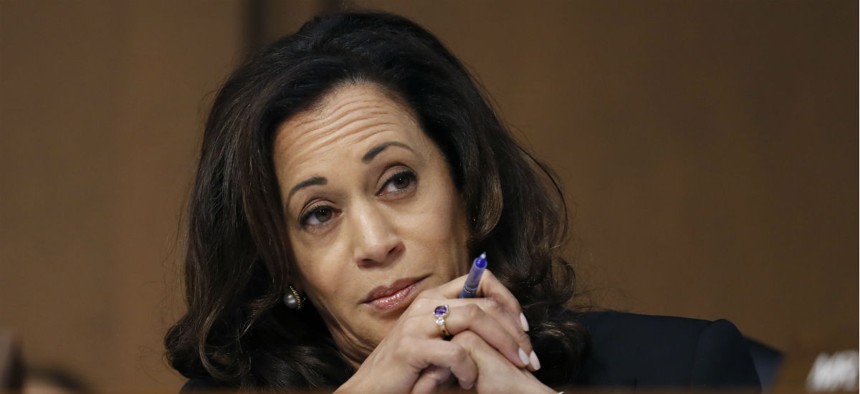The Federal Government Has Gotten Slower at Hiring New Employees for 5 Consecutive Years
Senator calls the trend a "crisis," while OPM says it is "disappointing."
After a few years in which the federal government dramatically decreased the average time it takes to bring on new employees, hiring times have steadily crept back up. Agencies have taken longer to recruit and onboard workers in each of the last five years.
The governmentwide average time to hire in fiscal 2017 was 106 days, up from the 87-day average agencies experienced in fiscal 2012. That trend is a reversal from the one seen early in the Obama administration, when agencies decreased the average wait time for applicants from 122 days in fiscal 2009. Sen. James Lankford, R-Okla, who chairs the Senate Homeland Security and Governmental Affairs Committee’s federal management panel called the situation a “crisis,” while an Office of Personnel Management conceded the figure was “disappointing.”
By comparison, a study from Glassdoor Economic Research found the typical process of getting hired in the United States in 2014 was 23 days.
Sen. Steve Daines, R-Mont., said the delays would lead to agencies recruiting an inadequate workforce.
The worse candidates, he said, “are the ones who hang out for 106 days because they have no other options.” The best candidates, he added, have several options from which to choose and will not wait for the final government offer.
Mark Reinhold, OPM’s associate director for employee services, did not get into specifics but said Congress could help agencies hire more quickly.
“Hiring the best available talent must be a management priority, administered through a modern system that enables trained and engaged managers to fill jobs with top candidates who meet the current needs of agencies and will excel in their public service to our nation,” Reinhold said. “With your support, we can get there.”
He noted that OPM has already sent specific legislative proposals to Congress, which Lankford and others were helping to turn into actual bills. Some agency representatives said they would like to see more direct hiring authority, including by gaining the ability to make conditional job offers on the spot during recruiting events. Reinhold called direct hire authority a “really important flexibility” and discussed an openness to “update the rules,” but emphasized the “longstanding principles” reflected in the traditional process.
Reinhold said agencies could make “huge gains” by investing in tools and technology that help them drill down on their hiring shortfalls. He also highlighted a program OPM recently launched called Federal Human Resources Institute, which will offer 22 courses for HR professionals throughout government to help them better deliver services such as staffing, classification and performance management. Reinhold added that OPM “fully supports” the Trump administration's push to boost employee accountability and the agency is “looking at ways [to] move the ball on that.”
Lawmakers and administration officials repeatedly stressed the need to better train and equip managers to reduce turnover and identify and recruit top applicants. Witnesses identified an array of proposals to improve managers’ skills, ranging from legislative fixes to unusual development programs.
Angela Bailey, chief human capital officer at the Homeland Security Department, said she had implemented training for Senior Executive Service members to discuss King Henry V and “what he went through with regard to inspiring his troops.”
“You may say, ‘Well what the heck does that have to do with really employee engagement?’ but to a person every SES walked out of there and said, ‘I just learned something,’” Bailey said. She added that training funding is often the first to be cut when agency belts are tightened and civilian agencies should adopt “the same kind of mindset” as the military with regard to that priority.
Bailey faced heated questioning from Democratic senators on President Trump’s mandate that DHS hire 15,000 new law enforcement personnel and thousands of additional support staff. Sen. Kamala Harris, D-Calif., asked Bailey how the department justified the specific numbers of new agents at Immigration and Customs Enforcement and Customs and Border Protection. Bailey said the numbers were based on workforce modelling DHS had conducted, contradicting an inspector general report last year that found there was no need for the hiring sprees and the department could produce no documentation to support them. It was also at odds with comments acting ICE Director Thomas Homan made last year.
“Ten-thousand did not come from ICE,” Homan said in May of its hiring mandate. “I don’t know where it came from but it did not come from ICE.”
Bailey promised to deliver the model to Harris by the end of the month. Harris “looks forward to receiving” it, a spokesman said after the hearing.
“Sen. Harris remains deeply concerned that this hiring surge is nothing more than an attempt to fulfill a campaign quota,” said Tyrone Gayle, the spokesman. “Instead of rapidly hiring new agents, DHS should focus on well-documented management challenges, including addressing issues such as pay and training for current law enforcement personnel.”
Bailey was also placed on defense when Sen. Heidi Heitkamp, D-N.D., questioned a contract CBP signed with Accenture to reach its hiring objectives. The contract is worth $297 million, which will lead to CBP paying Accenture $40,000 per hire. Heitkamp noted the Border Patrol’s high attrition rate and said the agency should instead spend that money on retention and recruitment incentives.
“What are we doing here?” Heitkamp asked. “This is not being well received on this committee.”
NEXT STORY: People Don't Actually Know Themselves Very Well








